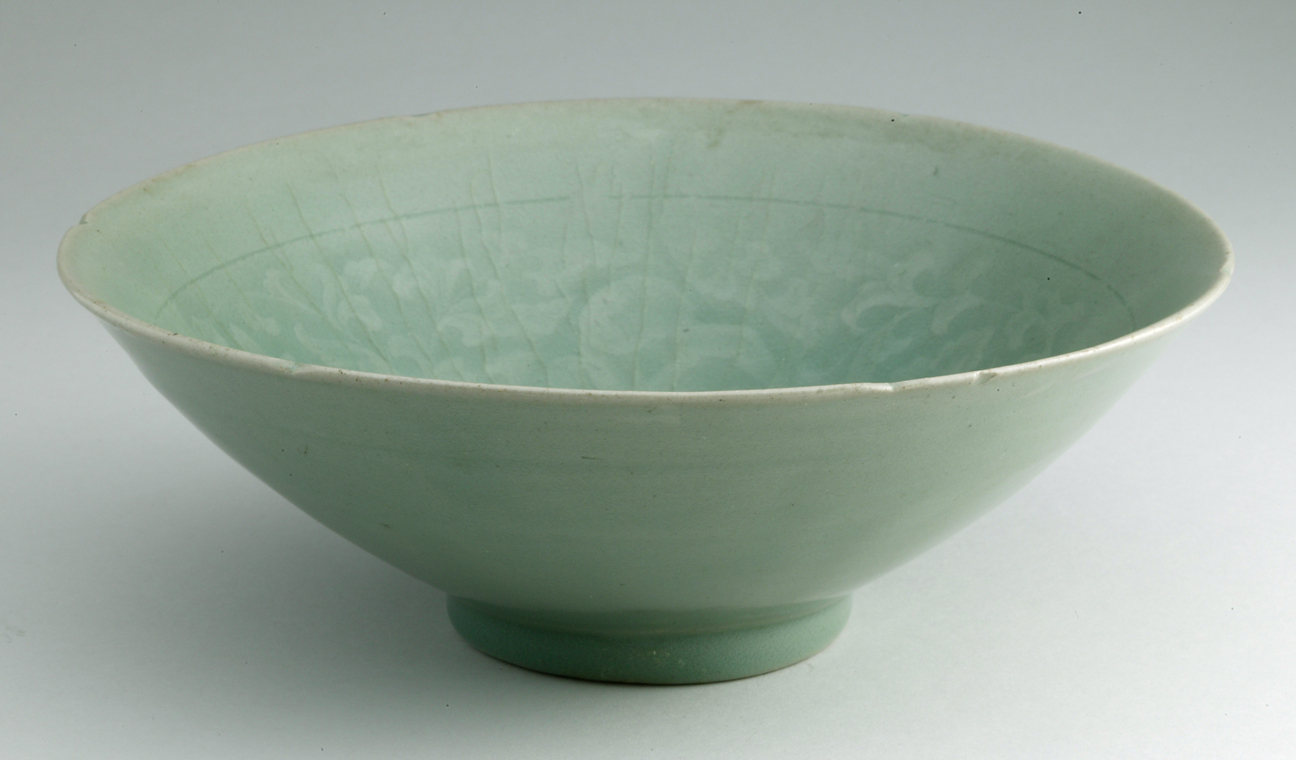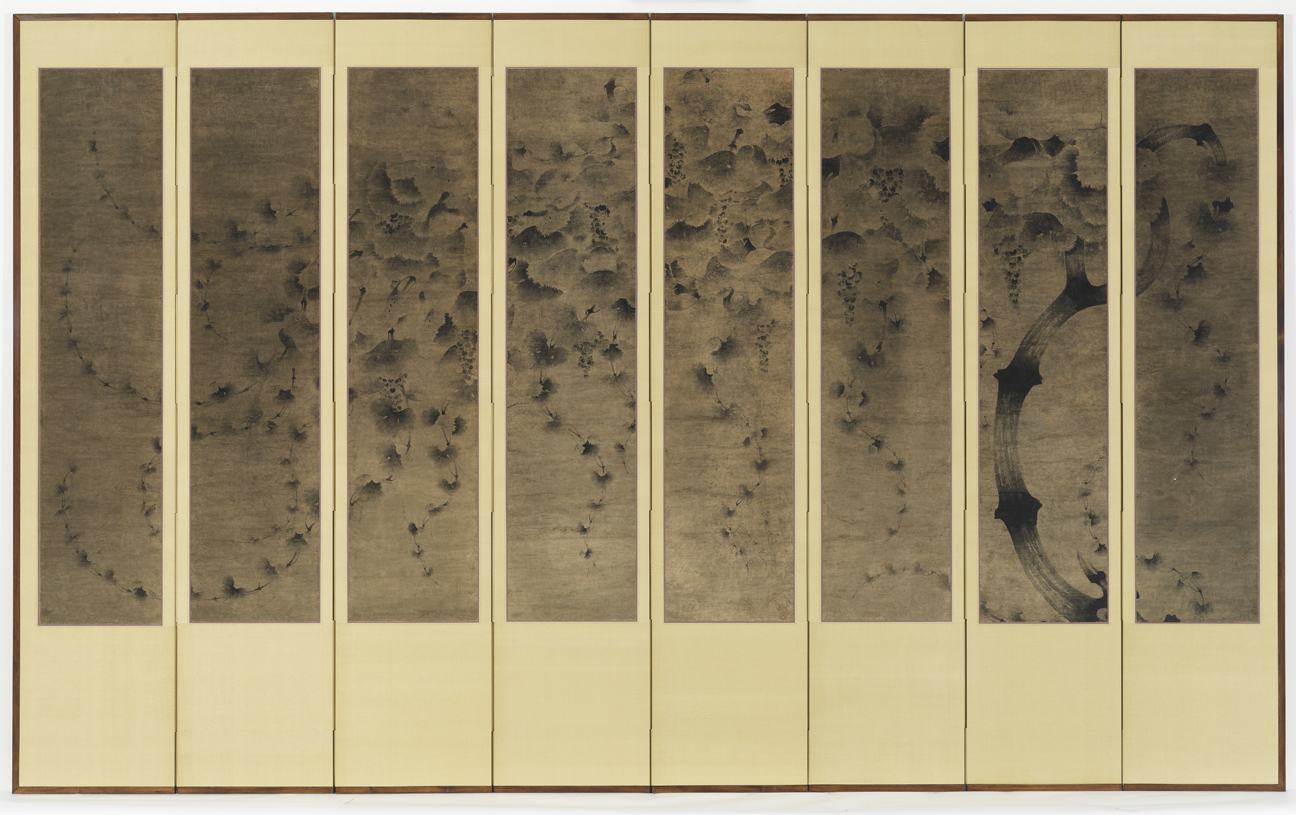Infants in Asian Art
Children are ubiquitous in Asian art. Two of my favorite examples in HoMA’s collection are from Korea. The first is a celadon bowl from the 12th century, a golden age when Korea surpassed most of the world in the quality of its ceramics. The bowl’s decoration was made using a mold, a technique that reached perfection then, and shows infants playing in a pond full of lotus blossoms.

Bowl with Children Playing Among Lotuses, Korea, 12th century. Stoneware with celadon glaze. Gift of Anna Rice Cooke, 1927 (150)
The second is a screen from some six hundred years later, depicting infants hidden among grape vines. This screen came into the museum as eight individual, loose sheets of paper, and I remember well when we finally were able to have it mounted. The infant faces are skillfully disguised, and we didn’t realize that the subject included anything other than a vineyard. When we were examining the screen for the first time after it was mounted, we suddenly saw one pair of eyes peek out, then another, and soon we were finding babies all across the painting.

Grape Vines and Children, Korea, 18th century.Eight-panel screen; ink on paper. Purchase, Richard Lane Collection, 2003(2010.0007)
Of course, infants symbolize many of the same ideas in Asia as the rest of the world, from purity to progeny. However, just as Raphael’s all-too-adorable putti reference ancient Roman mysteries and awe-inspiring Hebrew cherubim, there are deeper historical currents behind these infants that never become completely sublimated. It is a fascinating tale of medieval magic and esoteric beliefs that I would like to share with you here.
Our story begins with an ancient philosophical classic, the Daodejing or “Classic of the Way and Its Power,” attributed to a mysterious figure known as Laozi or the “Elder Master.” In the centuries after this text was compiled, it became increasingly associated with spiritual practices and religious beliefs, particularly those surrounding the quest for immortality, which preoccupied many emperors and other elites. Eventually, in the second century, the Daodejing became the central scripture of an organized religious movement (that would evolve into Taoism, China’s primary indigenous religion), and Laozi became its supreme deity. One of the interesting, and perhaps unexpected, things that resulted from this was a new interpretation of Laozi’s name. The “zi” in the name was commonly used as an honorific, similar to “Master” in English; most early philosophers were referred to in this manner, and Confucius, for example, is a Latinization of the Chinese name Kongzi, “Master Kong.” At the same time, “zi” literally means “child.” The medieval religious mind had a particular love for paradox, and reading Laozi’s name literally as “Old Infant” was too tempting to resist.
It is important to remember that immortality was understood in physical terms. The primary goal of immortality was preservation of the actual body. But, the body didn’t necessarily have to stay the same once immortality was achieved. In fact, the more skilled one became at magical techniques, the more youthful one’s body was. One historical visionary from the fourth century who left behind diary accounts of his meetings with his immortal teacher described her as appearing to be around twelve years old. And yet, a century earlier before she had herself attained immortality, she had lived a full life, been married and had children. The higher one rose in the hierarchy of immortals, the more youthful one became, up to the point that the greatest masters such as Laozi literally looked like infants, even though they were thousands of years old.
Other beliefs introduced with Buddhism further enforced this concept and provided additional nuances. In particular, the paradise of Amitabha Buddha was described as a divine garden filled with infants emerging from lotus blossoms. All those who called upon Amitabha as they were dying would be reborn into this paradise. However, some souls were purer than others, and those that still needed to be cleansed of their karmic pollution (a process that could take centuries), would be reborn into a closed lotus blossom. When they were finally ready, the flower would open and they would emerge as a newly radiant infant.
Ultimately, the pursuit of physical immortality fell out of favor—no doubt in part due to the many poisoning deaths from elixirs made with such substances as cinnabar and mercury. As Taoist deities became more closely associated with the emperors (Laozi himself was considered the ancestor of the Tang imperial family), describing them as infants started to seem inappropriate, and they took on a more respectable adult demeanor. The children playing in a lotus pond decorating HoMA’s celadon bowl are more reserved than the heads popping out of lotuses in the more imaginative medieval images of Amitabha’s paradise. But the influence of these ideas lingered, and in addition to symbolizing more pedestrian wishes—such as for numerous descendants—infants as a theme in the arts would have suggested at least a vague hope for immortality as well.
– Shawn Eichman, Curator of Asian Art
6.29.2020